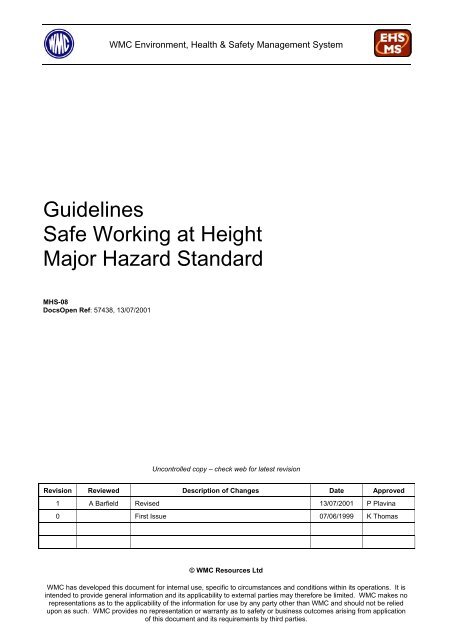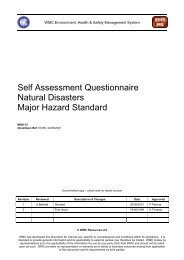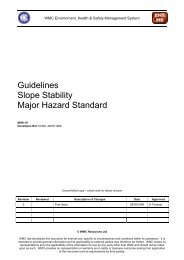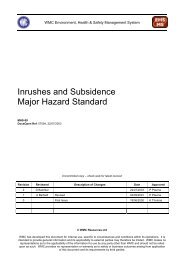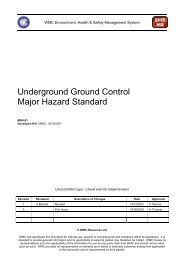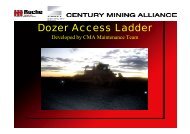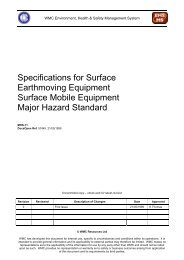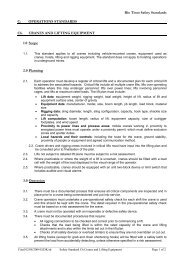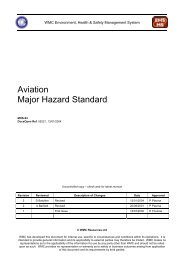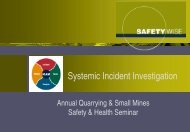Guidelines Safe Working at Height Major Hazard Standard - MIRMgate
Guidelines Safe Working at Height Major Hazard Standard - MIRMgate
Guidelines Safe Working at Height Major Hazard Standard - MIRMgate
You also want an ePaper? Increase the reach of your titles
YUMPU automatically turns print PDFs into web optimized ePapers that Google loves.
WMC Environment, Health & <strong>Safe</strong>ty Management System<br />
<strong>Guidelines</strong><br />
<strong>Safe</strong> <strong>Working</strong> <strong>at</strong> <strong>Height</strong><br />
<strong>Major</strong> <strong>Hazard</strong> <strong>Standard</strong><br />
MHS-08<br />
DocsOpen Ref: 57438, 13/07/2001<br />
Uncontrolled copy – check web for l<strong>at</strong>est revision<br />
Revision Reviewed Description of Changes D<strong>at</strong>e Approved<br />
1 A Barfield Revised 13/07/2001 P Plavina<br />
0 First Issue 07/06/1999 K Thomas<br />
© WMC Resources Ltd<br />
WMC has developed this document for internal use, specific to circumstances and conditions within its oper<strong>at</strong>ions. It is<br />
intended to provide general inform<strong>at</strong>ion and its applicability to external parties may therefore be limited. WMC makes no<br />
represent<strong>at</strong>ions as to the applicability of the inform<strong>at</strong>ion for use by any party other than WMC and should not be relied<br />
upon as such. WMC provides no represent<strong>at</strong>ion or warranty as to safety or business outcomes arising from applic<strong>at</strong>ion<br />
of this document and its requirements by third parties.
<strong>Major</strong> <strong>Hazard</strong> <strong>Standard</strong> Rel<strong>at</strong>ed Document<br />
<strong>Guidelines</strong> for the <strong>Safe</strong> <strong>Working</strong> <strong>at</strong><br />
<strong>Height</strong>s <strong>Standard</strong><br />
1 Purpose .................................................2<br />
2 Planning for Work <strong>at</strong> <strong>Height</strong>s ..............2<br />
2.1 Work Planning Techniques ................2<br />
2.2 Planning Inform<strong>at</strong>ion ..........................2<br />
2.3 Task Assignment ...............................2<br />
3 Design, Development and Acquisition<br />
of New Facilities..................................2<br />
4 Inspections............................................2<br />
5 Use and Maintenance of <strong>Safe</strong>ty Belts,<br />
Full Body Harnesses, PFAE and<br />
PFRE ....................................................3<br />
6 Anchor Points for Fall Restraint and<br />
Fall Arrest ............................................3<br />
6.1 Personnel Anchor Points in<br />
Underground <strong>Working</strong>s.....................3<br />
6.2 Other Personnel Anchor Points..........3<br />
6.3 All Personnel Anchorage Points.........3<br />
6.4 St<strong>at</strong>ic Lines ........................................3<br />
7 Design, Construction and Use of<br />
Permanent Work Pl<strong>at</strong>forms................4<br />
8 Design and Construction of Stairs......4<br />
9 Design and Construction of Fixed<br />
Ladders ................................................4<br />
10 Portable Ladders ................................4<br />
10.1 Design and Construction..................4<br />
10.2 Use of Portable Ladders ..................4<br />
10.3 Disposal of Ladders .........................5<br />
11 Flexible Ladders................................. 5<br />
11.1 Design and Construction..................5<br />
11.2 Use of Flexible Ladders....................5<br />
12 Design, Construction and Use of<br />
Mobile Work Pl<strong>at</strong>forms....................... 5<br />
12.1 Mancages.........................................5<br />
13 Scaffolding.......................................... 6<br />
13.1 General ............................................6<br />
13.2 Prior to Mobilis<strong>at</strong>ion..........................6<br />
13.3 Arrival on Site...................................6<br />
13.4 Work Area ........................................6<br />
13.5 Scaffold Requirements.....................6<br />
13.6 Constructing and Dismantling ..........6<br />
13.7 <strong>Working</strong> from Scaffolds ....................7<br />
13.8 Portable Ladders for Scaffold Access7<br />
14 <strong>Working</strong> on Mobile Equipment.......... 7<br />
15 <strong>Working</strong> Around Open Holes ............ 7<br />
16 Rill Ropes............................................ 8<br />
17 <strong>Working</strong> on Roofs .............................. 8<br />
18 <strong>Working</strong> in Ceiling Spaces ................ 8<br />
19 Recording Requirements................... 8<br />
20 Competencies..................................... 9<br />
APPENDICES ......................................... 10<br />
A Portable Ladder Inspection.....................10<br />
B Checklist for Inspecting Self-Locking<br />
Anchorages..........................................11<br />
C Inspection of Belts and Harnesses<br />
Checklist ..............................................12<br />
** Uncontrolled copy. Use l<strong>at</strong>est revision **<br />
SAF-MHS08-R01 Rev. 1 DOCS: 57438 Issued: 13/07/00 Page 1 of 12
<strong>Major</strong> <strong>Hazard</strong> <strong>Standard</strong> Rel<strong>at</strong>ed Document<br />
<strong>Guidelines</strong> for the <strong>Safe</strong> <strong>Working</strong> <strong>at</strong> <strong>Height</strong>s <strong>Standard</strong><br />
** Uncontrolled copy. Use l<strong>at</strong>est revision **<br />
1 Purpose<br />
This guideline is to be read in conjunction with <strong>Safe</strong><br />
<strong>Working</strong> <strong>at</strong> <strong>Height</strong> <strong>Standard</strong> (SAF-MHS-08) The aim<br />
of this guideline is to enable sites to implement a safe<br />
system of working <strong>at</strong> height.<br />
2 Planning for Work <strong>at</strong> <strong>Height</strong>s<br />
2.1 Work Planning Techniques<br />
For all work <strong>at</strong> height, there is to be a formal risk<br />
assessment to establish the hazards and controls to<br />
ensure a safe system of work.<br />
Risk assessment results are to:<br />
• Be incorpor<strong>at</strong>ed into a checklist<br />
• Ensure adequ<strong>at</strong>e provisions for controlling the<br />
hazards of working <strong>at</strong> height<br />
• Ensure any devi<strong>at</strong>ion from the original scope of<br />
work is re-evalu<strong>at</strong>ed.<br />
2.2 Planning Inform<strong>at</strong>ion<br />
Sites are to ensure th<strong>at</strong> there is an up-to-d<strong>at</strong>e<br />
inform<strong>at</strong>ion set th<strong>at</strong> reflects the as-built condition.<br />
2.3 Task Assignment<br />
The task assignment system is to include progress<br />
and hand over provision for jobs done where the<br />
work force may change.<br />
3 Design, Development and<br />
Acquisition of New Facilities<br />
Removing the risk of falls from height is best<br />
achieved by removing the need to work <strong>at</strong> height.<br />
Each site is to have a Design, Development and<br />
Acquisition system th<strong>at</strong> addresses the risks arising<br />
from working <strong>at</strong> height.<br />
This system is to include:<br />
• Procedures th<strong>at</strong> ensure, where possible, the need to<br />
work <strong>at</strong> height is elimin<strong>at</strong>ed<br />
• Consider<strong>at</strong>ion of all construction, oper<strong>at</strong>ing,<br />
modific<strong>at</strong>ion and maintenance activities for the<br />
foreseeable life of the asset<br />
• A team based risk assessment approach,<br />
incorpor<strong>at</strong>ing end-users, capturing all relevant<br />
inform<strong>at</strong>ion on safe work <strong>at</strong> height. The risk<br />
assessment is to be used prior to construction or<br />
modific<strong>at</strong>ion work, and wherever possible, utilise<br />
hazard checklists and include ergonomic<br />
consider<strong>at</strong>ions<br />
• Procedures th<strong>at</strong> ensure all provisions to prevent<br />
falls from height are clearly identified in<br />
purchasing inform<strong>at</strong>ion<br />
• Purchasing procedures th<strong>at</strong> ensure provisions to<br />
prevent falls are not changed without the formal<br />
agreement with the origin<strong>at</strong>or<br />
• Procedures th<strong>at</strong> ensure persons designing,<br />
acquiring, constructing and modifying facilities<br />
have the necessary competence to assess and<br />
implement the requirements for safe work <strong>at</strong><br />
heights.<br />
4 Inspections<br />
Each site is to have an inspection system th<strong>at</strong><br />
includes a record of:<br />
• completed inspections<br />
• faults found<br />
• repairs required and completed<br />
• specific equipment identific<strong>at</strong>ion<br />
• specific inspection checklists<br />
• means of identifying the currency of the equipment<br />
• required inspection time frames<br />
• persons authorised to conduct inspections<br />
• persons authorised to carryout repairs.<br />
The inspection system is to include the following<br />
areas:<br />
• Anchor points<br />
• Harness and accessories<br />
• Lanyards and accessories<br />
• St<strong>at</strong>ic lines and accessories and st<strong>at</strong>ic line anchor<br />
points to structures<br />
• Rope systems and accessories<br />
• Mobile work pl<strong>at</strong>forms and <strong>at</strong>tachments<br />
• Scaffolds and access equipment<br />
• Work pl<strong>at</strong>forms and access equipment<br />
• Stairs<br />
• Portable stands<br />
• Ladders.<br />
The inspection checklists should include items such<br />
as:<br />
• Physical damage<br />
• Wear<br />
• Corrosion/erosion<br />
• Distortion and deform<strong>at</strong>ion<br />
• Metal f<strong>at</strong>igue<br />
• Deterior<strong>at</strong>ion<br />
• Identific<strong>at</strong>ion markings<br />
SAF-MHS08-R01 Rev. 1 DOCS: 57438 Issued: 13/07/00 Page 2 of 12
<strong>Major</strong> <strong>Hazard</strong> <strong>Standard</strong> Rel<strong>at</strong>ed Document<br />
<strong>Guidelines</strong> for the <strong>Safe</strong> <strong>Working</strong> <strong>at</strong> <strong>Height</strong>s <strong>Standard</strong><br />
** Uncontrolled copy. Use l<strong>at</strong>est revision **<br />
• Storage<br />
• Labelling (safety instructions etc.)<br />
• St<strong>at</strong>utory requirements.<br />
• For examples of checklists see Appendices and<br />
refer to:<br />
• AS 1891 part 1,2 and 3<br />
• AS 2626 Industrial <strong>Safe</strong>ty Belts and Harnesses -<br />
Selection, Use and Maintenance<br />
• AS 4626 Industrial Fall Arrest Devices - Selection,<br />
Use and Maintenance<br />
5 Use and Maintenance of <strong>Safe</strong>ty<br />
Belts, Full Body Harnesses, PFAE<br />
and PFRE<br />
Refer to AS 2626, AS 4626 and AS 1891 for further<br />
inform<strong>at</strong>ion, these standards are to be read in<br />
conjunction with the “<strong>Safe</strong> <strong>Working</strong> <strong>at</strong> <strong>Height</strong>s”<br />
<strong>Standard</strong> (SAF-MHS-08).<br />
Where required, this equipment should be made<br />
readily available <strong>at</strong> the work site.<br />
6 Anchor Points for Fall Restraint<br />
and Fall Arrest<br />
6.1 Personnel Anchor Points in Underground<br />
<strong>Working</strong>s<br />
Anchor points into rock should:<br />
• Not be used for scraping/ lifting<br />
• Comprise two anchor pins offset and have a<br />
combined load carrying capacity of no less than<br />
20 kN<br />
• Be clearly identified (e.g. painted fluorescent<br />
orange) and inspected <strong>at</strong> regular intervals<br />
• Be inspected immedi<strong>at</strong>ely prior to use to ensure the<br />
integrity of the anchor (shall be sound and firm)<br />
Any anchor pins found to be insecure shall be clearly<br />
identified and cut off or made unusable as soon as<br />
possible.<br />
Where these anchor points are susceptible to<br />
deterior<strong>at</strong>ion due to environmental conditions<br />
(e.g. type of ground, wet, salt) additional measures<br />
shall be taken (e.g. grout, chemical anchor,<br />
galvanised).<br />
Other anchor points th<strong>at</strong> may be used are as follows:<br />
• Mobile equipment th<strong>at</strong>:<br />
– weighs two tonne or more, and<br />
– has a closed anchorage point e.g. towing ring,<br />
hole in bucket but no open hooks, and<br />
– is isol<strong>at</strong>ed, tagged out and secured/parked to stop<br />
any movement e.g. parked into wall, bucket<br />
down, park brake on, wheels chocked, parked<br />
side on, etc.<br />
• Fixed plant or structures:<br />
– Able to withstand 15 kN breaking force<br />
– Shall have a closed anchorage point<br />
e.g. no open hooks.<br />
6.2 Other Personnel Anchor Points<br />
Where anchor points are required as part of the safe<br />
system of work these points should be:<br />
• Able to withstand 15 kN breaking force.<br />
• Closed e.g. no open hooks.<br />
• Clearly identified (e.g. painted fluorescent orange)<br />
and inspected <strong>at</strong> regular intervals.<br />
• Inspected immedi<strong>at</strong>ely prior to use to ensure the<br />
integrity of the anchor (shall be sound and firm).<br />
• Clearly identified and removed/ repaired/ replaced<br />
as soon as possible when found to be insecure.<br />
Other anchor points th<strong>at</strong> may be used are as follows.<br />
Where no suitable fixed structures exist, mobile<br />
equipment may be used provided it complies with the<br />
following:<br />
• Weighs two tonne or more, and<br />
• Has a closed anchorage point e.g. towing ring, hole<br />
in bucket but no open hooks, and<br />
• Two anchor points are used where possible, and<br />
• Is isol<strong>at</strong>ed, tagged out and secured/parked to stop<br />
any movement e.g. bucket down, park brake on,<br />
wheels chocked, parked side on, etc.<br />
•<br />
6.3 All Personnel Anchorage Points<br />
• Should be installed by an appropri<strong>at</strong>ely competent<br />
person.<br />
• Personnel equipment should not be <strong>at</strong>tached to the<br />
anchor point by looping through and back locking<br />
the rope e.g. use a shackle or sling and then the<br />
direct hook from the personnel equipment.<br />
• All extensions or components for the anchorage<br />
point e.g. slings, shackles, etc. should have a<br />
minimum r<strong>at</strong>ing of two tonnes. It is recommended<br />
th<strong>at</strong> the shackles used for this purpose are the pin<br />
and safety clip type (bow shackles) not the screw<br />
pin type.<br />
6.4 St<strong>at</strong>ic Lines<br />
All St<strong>at</strong>ic Lines should comply with the requirements<br />
of the AS 1891 part 2 1998 and the ‘Code of Practice<br />
for Prevention of Falls <strong>at</strong> Work’ Worksafe Western<br />
Australia Commission September 1997:<br />
SAF-MHS08-R01 Rev. 1 DOCS: 57438 Issued: 13/07/00 Page 3 of 12
<strong>Major</strong> <strong>Hazard</strong> <strong>Standard</strong> Rel<strong>at</strong>ed Document<br />
<strong>Guidelines</strong> for the <strong>Safe</strong> <strong>Working</strong> <strong>at</strong> <strong>Height</strong>s <strong>Standard</strong><br />
** Uncontrolled copy. Use l<strong>at</strong>est revision **<br />
• Be suitable for the prevailing environmental<br />
conditions e.g. Stainless, galvanised, etc.<br />
• Only be installed by a competent and authorised<br />
person<br />
• Be inspected (as per AS 4626) <strong>at</strong> regular intervals<br />
(maximum 3 monthly) and immedi<strong>at</strong>ely prior to<br />
use<br />
• Be removed from service and replaced immedi<strong>at</strong>ely<br />
if found to be defective.<br />
• Landings/ rest points <strong>at</strong> 6 metre intervals and hoops<br />
and cages fitted above 2.2 metres from the bottom<br />
of the ladder<br />
All existing ladders should comply with the above<br />
requirements.<br />
Note: All sites should review their existing ladders<br />
(including escape ways) with reference to the design,<br />
physical condition of the ladders and ability of<br />
persons having to use the ladders in an emergency.<br />
7 Design, Construction and Use of<br />
Permanent Work Pl<strong>at</strong>forms<br />
Permanent work pl<strong>at</strong>forms are fixed structures th<strong>at</strong><br />
allow access to a work area <strong>at</strong> any time and should<br />
meet the following requirements:<br />
As a minimum, a work pl<strong>at</strong>form should meet the<br />
requirements of AS 1657 and:<br />
• Be designed and constructed to carry the<br />
anticip<strong>at</strong>ed loads. Handrails are to withstand a<br />
minimum of 0.55 kN (55 kg dead weight<br />
equivalent)<br />
• Have a firm, level surface th<strong>at</strong> does not move while<br />
being walked upon<br />
• Have a bar or g<strong>at</strong>e (which should be self-closing)<br />
fitted to openings in handrails for downward<br />
access.<br />
•<br />
8 Design and Construction of<br />
Stairs<br />
Stairs should be designed and constructed to<br />
AS1657.<br />
The stairs should <strong>at</strong> least have:<br />
• Edge protection on exposed sides<br />
• Returns and intermedi<strong>at</strong>e pl<strong>at</strong>forms fitted with edge<br />
protection.<br />
All steps should have non-slip nosing.<br />
Each site should conduct a review of their existing<br />
stairways for compliance with the requirements of<br />
the <strong>Safe</strong> <strong>Working</strong> <strong>at</strong> <strong>Height</strong>s standard.<br />
9 Design and Construction of<br />
Fixed Ladders<br />
All new fixed ladders should be designed and<br />
constructed to AS 1657. If the ladder extends more<br />
than 6 metres the design is to include either:<br />
• The provision of fall-arrest system (e.g. p<strong>at</strong>ented<br />
ladder-climb systems), or<br />
10 Portable Ladders<br />
Any ladder th<strong>at</strong> is capable of being transferred from<br />
one loc<strong>at</strong>ion to another is considered a portable<br />
ladder.<br />
10.1 Design and Construction<br />
All portable ladders should comply with the<br />
requirements of AS 1892.<br />
10.2 Use of Portable Ladders<br />
When working from a portable ladder the following<br />
should be followed:<br />
• When personnel use a single or extension ladder,<br />
the ladder is to be either securely anchored <strong>at</strong> the<br />
top or held firmly by another person<br />
• Personnel using a single or extension ladder have<br />
either both feet and one hand or one foot and two<br />
hands in contact with the ladder or they are secured<br />
by a fall arrest device<br />
• Surfaces for placing ladders are to be firm and<br />
level<br />
• The distance between the ladder base and the<br />
supporting structure should be 1 metre for every<br />
4 metres of working ladder height (r<strong>at</strong>io of 4:1)<br />
• All access ladders shall be secured against<br />
movement and extend <strong>at</strong> least 1 metre above the<br />
work pl<strong>at</strong>form level<br />
• One person on the ladder <strong>at</strong> a time<br />
• When ladders are used in areas subject to either<br />
personnel or vehicle traffic, precautions must be<br />
taken to prevent inadvertent contact with the ladder<br />
e.g. Barricade, signage, flashing lights, etc.<br />
• All sites are to have an inspection system th<strong>at</strong> ensures<br />
periodic inspection and servicing of all portable<br />
ladders. A log is to be kept of inspections and all<br />
ladders are to be marked as inspected<br />
• Ladders should not be used unless within current<br />
inspection d<strong>at</strong>e and in good condition. (An<br />
example of a Portable Ladder Inspection Checklist<br />
is <strong>at</strong>tached in Appendix A).<br />
SAF-MHS08-R01 Rev. 1 DOCS: 57438 Issued: 13/07/00 Page 4 of 12
<strong>Major</strong> <strong>Hazard</strong> <strong>Standard</strong> Rel<strong>at</strong>ed Document<br />
<strong>Guidelines</strong> for the <strong>Safe</strong> <strong>Working</strong> <strong>at</strong> <strong>Height</strong>s <strong>Standard</strong><br />
** Uncontrolled copy. Use l<strong>at</strong>est revision **<br />
10.3 Disposal of Ladders<br />
Where ladders do not comply with the inspection<br />
criteria the ladder is to be repaired to pass inspection<br />
or destroyed.<br />
11 Flexible Ladders<br />
11.1 Design and Construction<br />
The design and construction of a flexible ladder will<br />
be determined by the environment and intended use<br />
and only to be constructed by an appropri<strong>at</strong>ely<br />
qualified manufacturer.<br />
11.2 Use of Flexible Ladders<br />
Flexible ladders should only be used when all other<br />
methods of access have been considered and deemed<br />
inappropri<strong>at</strong>e. Other requirements are:<br />
• PFAE should be used when using flexible ladders<br />
• Flexible ladders should be stored in an appropri<strong>at</strong>e<br />
storage area to manufacturers requirements<br />
• All sites should have an inspection system th<strong>at</strong><br />
ensures periodic inspection and servicing of all<br />
flexible ladders<br />
• A log is to be kept of inspections and all ladders are<br />
to be marked as inspected<br />
• Ladders should not be used unless within current<br />
inspection d<strong>at</strong>e and in good condition<br />
• Where ladders do not comply with the inspection<br />
criteria the ladder should be repaired to pass<br />
inspection or destroyed.<br />
12 Design, Construction and Use of<br />
Mobile Work Pl<strong>at</strong>forms<br />
Sites should comply with the requirements of<br />
SAF-MHS-05 Underground Mobile Equipment and<br />
the SAF-MHS-11 Surface Mobile Equipment.<br />
When the work pl<strong>at</strong>form is <strong>at</strong>tached to an item of<br />
mobile equipment and in the raised position, the<br />
oper<strong>at</strong>or of the mobile equipment should not leave<br />
the oper<strong>at</strong>ing position.<br />
12.1 Mancages<br />
A mancage is an approved, engineered and<br />
constructed cage suspended from a crane for the<br />
purpose of lifting and lowering personnel to perform<br />
tasks on inaccessible plant or equipment.<br />
Each site where mancages are used shall have a<br />
written procedure th<strong>at</strong> includes a risk assessment<br />
prior to each use.<br />
Mancages should be approved and registered by the<br />
appropri<strong>at</strong>e authority and a compliance pl<strong>at</strong>e must be<br />
affixed to the mancage to indic<strong>at</strong>e th<strong>at</strong> it is<br />
registered/approved.<br />
Mancages should be only be used when:<br />
• We<strong>at</strong>her conditions are suitable<br />
• A licensed and authorised crane driver oper<strong>at</strong>es the<br />
crane<br />
• All certific<strong>at</strong>es of testing for the mancage, crane<br />
and all associ<strong>at</strong>ed equipment (slings etc.) are<br />
current<br />
• All personnel involved in the work are aware of the<br />
procedure to be followed<br />
• There is an effective means of communic<strong>at</strong>ing<br />
between the persons in the cage and the crane<br />
driver<br />
• The crane driver remains <strong>at</strong> the crane controls <strong>at</strong> all<br />
times whilst the mancage is in use<br />
• It is not possible for any part of the crane or load to<br />
be within 5 metres of any ‘live’ power lines<br />
• The crane is st<strong>at</strong>ionary<br />
• No other lifting is performed whilst the mancage is<br />
<strong>at</strong>tached<br />
• Personnel are secured inside the mancage <strong>at</strong> all<br />
times whilst the mancage is in use. Fully enclosed<br />
and/or the use of PFAE.<br />
Each mancage should:<br />
• Be specifically designed in accordance with<br />
AS 1418.17<br />
• Be clearly marked with:<br />
– the tare weight, and<br />
– the safe working load<br />
• Have the lifting slings permanently <strong>at</strong>tached to the<br />
cage by locked shackles, or similar means<br />
• Be regularly inspected and maintained in safe<br />
working condition<br />
• Have the access door, if fitted, open inwards and be<br />
able to be securely locked<br />
• Have a minimum of two persons <strong>at</strong> any time<br />
occupying the cage whilst in use. One of the<br />
persons in the mancage should be a licensed<br />
dogman<br />
• Be fitted with anchor points to allow both<br />
occupants to wear a safety harness (PFAE)<br />
<strong>at</strong>tached to the anchor points <strong>at</strong> all times whilst the<br />
mancage is in use<br />
• Whilst in use, in addition to lifting <strong>at</strong>tachments, be<br />
fitted with a safety sling securely anchored to the<br />
crane hoist rope, above the lifting hook<br />
• Be inspected prior to use to ensure all requirements<br />
are met.<br />
SAF-MHS08-R01 Rev. 1 DOCS: 57438 Issued: 13/07/00 Page 5 of 12
<strong>Major</strong> <strong>Hazard</strong> <strong>Standard</strong> Rel<strong>at</strong>ed Document<br />
<strong>Guidelines</strong> for the <strong>Safe</strong> <strong>Working</strong> <strong>at</strong> <strong>Height</strong>s <strong>Standard</strong><br />
** Uncontrolled copy. Use l<strong>at</strong>est revision **<br />
Cranes lifting a mancage should:<br />
• Have drive up and drive down controls on both the<br />
hoist and luffing motions<br />
• Be equipped with controls th<strong>at</strong> return to the neutral<br />
position when released and this action causes the<br />
motion to stop<br />
• Be fitted with oper<strong>at</strong>ional warning or limiting<br />
devices to prevent overwinding of the hoist drum<br />
• Be equipped with outriggers and have them<br />
extended <strong>at</strong> all times whilst the mancage is in use<br />
• Have all free fall devices locked out, whilst the<br />
mancage is in use.<br />
13 Scaffolding<br />
13.1 General<br />
13.2 Prior to Mobilis<strong>at</strong>ion<br />
All specific job requirements including the need for a<br />
JSA or other specialised requirements should be<br />
discussed. Where required, all JSAs are to be<br />
submitted prior to mobilis<strong>at</strong>ion.<br />
13.3 Arrival on Site<br />
The scaffolding contractor should provide evidence<br />
(e.g. log book) th<strong>at</strong> equipment is regularly checked<br />
and is in a safe condition in line with AS 1576 and<br />
AS 1577.<br />
Equipment can also be checked by the competent and<br />
authorised WMC Supervisor responsible for the job.<br />
WMC owned equipment should be subject to the<br />
same requirements and be checked prior to use.<br />
13.4 Work Area<br />
The responsible WMC Supervisor and Contractor<br />
should determine an agreed safe position for the<br />
scaffolding.<br />
13.5 Scaffold Requirements<br />
The scaffolding should conform to the requirements<br />
of AS 1657, AS 1576 and AS 1577 (these standards<br />
can be found on the WMC Intranet Site) and include<br />
the following:<br />
13.5.1 <strong>Working</strong> Pl<strong>at</strong>form<br />
• Is free from any tripping hazards<br />
• The planking has no gaps gre<strong>at</strong>er than th<strong>at</strong> required<br />
for the lashing<br />
• The working surface is slip resistant, firm and level<br />
• Planks or working surface to be secured.<br />
13.5.2 Access to Pl<strong>at</strong>form<br />
The clear width of an access to the pl<strong>at</strong>form,<br />
measured between guardrails should be:<br />
• Not less than 675 mm for persons and m<strong>at</strong>erial<br />
• Not less than 450 mm for persons and hand tools.<br />
13.5.3 Slope of Pl<strong>at</strong>form<br />
The working pl<strong>at</strong>form should be level <strong>at</strong> all times.<br />
13.5.4 Kick/Toe Boards<br />
• Planks shall extend 150 mm above the surface of<br />
the pl<strong>at</strong>form<br />
• Gap between the kick/toe board and the pl<strong>at</strong>form<br />
shall not exceed 10 mm<br />
• The kick/toe board shall be secured and extend<br />
around the entire work pl<strong>at</strong>form unless<br />
• Where the kick/toe board is omitted due to access<br />
requirements to the work, the gap between the<br />
working face or structure shall be less than 100 mm<br />
(to prevent objects or person falling).<br />
•<br />
13.5.5 Guardrails<br />
• Guardrails should be securely fixed and parallel to<br />
the pl<strong>at</strong>form<br />
• A top rail should be between 900 mm and<br />
1100 mm from the pl<strong>at</strong>form<br />
• A mid rail should be <strong>at</strong> 600 mm from the pl<strong>at</strong>form<br />
unless fitted with an infill panel<br />
• When guard rails are omitted <strong>at</strong> the working face or<br />
adjacent to a structure/building, the gap between<br />
the structure/building and pl<strong>at</strong>form edge, should be<br />
less than 100 mm.<br />
13.5.6 Pl<strong>at</strong>form Access<br />
• Stairs should be in straight flights and not less than<br />
500 mm in width<br />
• The minimum head room for stairs should be<br />
1850 mm<br />
• The minimum clearance above landings should be<br />
1850 mm<br />
• Every access landing should have 450 mm clear<br />
around the landing point<br />
• Opening in hand railings for downward access<br />
from a pl<strong>at</strong>form, should be fitted with a bar or g<strong>at</strong>e<br />
and these are to be self-locking.<br />
13.6 Constructing and Dismantling<br />
• When constructing, altering or dismantling any<br />
scaffold, m<strong>at</strong>erials and equipment should not be<br />
thrown to persons above or below<br />
• When lifting and lowering equipment to and from<br />
upper levels an approved method should be used<br />
SAF-MHS08-R01 Rev. 1 DOCS: 57438 Issued: 13/07/00 Page 6 of 12
<strong>Major</strong> <strong>Hazard</strong> <strong>Standard</strong> Rel<strong>at</strong>ed Document<br />
<strong>Guidelines</strong> for the <strong>Safe</strong> <strong>Working</strong> <strong>at</strong> <strong>Height</strong>s <strong>Standard</strong><br />
** Uncontrolled copy. Use l<strong>at</strong>est revision **<br />
• While a scaffold is under construction and during<br />
dismantling, unless a safe system of work can<br />
ensure there is no potential for a fall PFAE should<br />
be worn and properly secured<br />
• A scaffold tagging system (which includes the<br />
structures load capacity) should be utilised <strong>at</strong> all<br />
times<br />
• The authorised scaffolder should display a ‘do not<br />
use scaffold’ tag <strong>at</strong> each access to a scaffold during<br />
construction, alter<strong>at</strong>ions and dismantling.<br />
• An appropri<strong>at</strong>e barricade and signage should be<br />
erected below the work area and the scaffold<br />
• All scaffolding and associ<strong>at</strong>ed equipment should be<br />
stored in a safe manner during construction and<br />
dismantling<br />
• All scaffolds should be inspected every 14 days<br />
and approved for use and have the approval tag<br />
upd<strong>at</strong>ed by a licensed scaffolder<br />
• When the access through a structure is required the<br />
height of frame should be 2 m, and the width of the<br />
walkway not less than 500 mm.<br />
• When the access height is less than standard and<br />
access is required precautions should be in place.<br />
e.g. foam is fixed to tubing and ‘Caution – Low<br />
Head Room’ signs in place.<br />
• Tube extensions should extend past the coupler by<br />
more than 10 mm. Tube extensions should be<br />
protected where there is a risk of contact with<br />
personnel on or about the scaffold.<br />
13.7 <strong>Working</strong> from Scaffolds<br />
• Access to all scaffolds should only occur after the<br />
scaffold is approved for use and the appropri<strong>at</strong>e<br />
approval tag is in place <strong>at</strong> the access point<br />
• All equipment, m<strong>at</strong>erials and tools required <strong>at</strong> the<br />
work area should be lifted and lowered using a<br />
method th<strong>at</strong> has been approved by a competent and<br />
authorised person<br />
• Work to be carried out on a scaffold should be<br />
within the load r<strong>at</strong>ing of the scaffold<br />
• At any time a person leaves the confines of the<br />
scaffold pl<strong>at</strong>form to carry out work <strong>at</strong> height, they<br />
should conform to the requirements of<br />
SAF-MHS-08 <strong>Safe</strong> <strong>Working</strong> <strong>at</strong> <strong>Height</strong><br />
• Where scaffolds are fitted with wheels the wheels<br />
should be locked whenever the scaffold is being<br />
used.<br />
13.8 Portable Ladders for Scaffold Access<br />
• All access ladders should be secured against<br />
movement and extend <strong>at</strong> least 1 m above the work<br />
pl<strong>at</strong>form level<br />
• Whilst securing the ladder there should be a person<br />
holding the base of the ladder to prevent movement<br />
• Ladders should be pitched <strong>at</strong> a minimum slope of<br />
one horizontally to four vertically and a maximum<br />
of one horizontally to six vertically<br />
• Persons should not carry m<strong>at</strong>erials, equipment or<br />
tools when climbing a ladder, maintain three point<br />
contact <strong>at</strong> all times<br />
• The maximum height between successive landings<br />
serviced by a portable ladder should not exceed<br />
6 m.<br />
14 <strong>Working</strong> on Mobile Equipment<br />
Work should not to be undertaken on mobile<br />
equipment where there is the risk of falling without<br />
adequ<strong>at</strong>e fall prevention measures in place.<br />
Each site should conduct a review of their existing<br />
equipment for compliance to the requirements of the<br />
<strong>Safe</strong> <strong>Working</strong> <strong>at</strong> <strong>Height</strong>s standard. All oper<strong>at</strong>ional<br />
and maintenance tasks required on the equipment<br />
should be included in the review.<br />
Pl<strong>at</strong>forms used for access to mobile equipment<br />
cabins, may be used for direct access from the<br />
ladder/stairway to the cabin only without using fall<br />
prevention equipment. When any work carried out on<br />
the pl<strong>at</strong>form or around the cabin could result in a fall,<br />
a safe system of work should be employed.<br />
When accessing the oper<strong>at</strong>ors cabin, three point<br />
contact should be maintained <strong>at</strong> all times. Equipment,<br />
m<strong>at</strong>erials or tools should not be carried up or down a<br />
ladder by hand.<br />
All equipment, m<strong>at</strong>erials and tools required <strong>at</strong> the<br />
work area should be lifted and lowered using a safe<br />
method.<br />
15 <strong>Working</strong> Around Open Holes<br />
A risk assessment process shall be used to define the<br />
controls required when personnel are exposed to<br />
open holes.<br />
Where indic<strong>at</strong>ed by the risk assessment, access points<br />
to an open hole shall have signs identifying the risk.<br />
Additional access controls may include barricades<br />
and/or the use of PFRE.<br />
Where work is to be conducted around open holes,<br />
(in the ground or in structures), a specific Job <strong>Safe</strong>ty<br />
Analysis (JSA) should be carried out and a <strong>Standard</strong><br />
Work Procedure (SWP) compiled prior to<br />
commencement of the work.<br />
Where it is necessary to have access past open holes<br />
to work areas, the standard work procedure should<br />
include either a physical barrier to prevent access to<br />
the open hole or, where this is not possible, a st<strong>at</strong>ic<br />
line to allow a safe passage around the hole. Where a<br />
st<strong>at</strong>ic line is installed, a sufficient number of fall<br />
restraint lanyards should be available <strong>at</strong> the job.<br />
SAF-MHS08-R01 Rev. 1 DOCS: 57438 Issued: 13/07/00 Page 7 of 12
<strong>Major</strong> <strong>Hazard</strong> <strong>Standard</strong> Rel<strong>at</strong>ed Document<br />
<strong>Guidelines</strong> for the <strong>Safe</strong> <strong>Working</strong> <strong>at</strong> <strong>Height</strong>s <strong>Standard</strong><br />
** Uncontrolled copy. Use l<strong>at</strong>est revision **<br />
16 Rill Ropes<br />
The minimum standard rope will be 20 mm<br />
non-deterior<strong>at</strong>ing rope or equivalent chain for hand<br />
over hand or handrail assistance applic<strong>at</strong>ions.<br />
Ropes to be 11 mm plus nylon or polyamide used in<br />
conjunction with rope grab type systems and a PFRE<br />
harness may also assist in some circumstances.<br />
Anchor points for rill ropes will be as per Section 6.1<br />
of this Guideline.<br />
Rill ropes should be inspected regularly and removed<br />
from service if they show signs of wear of<br />
deterior<strong>at</strong>ion.<br />
17 <strong>Working</strong> on Roofs<br />
Prior to working on or accessing any roof a risk<br />
assessment is to be conducted.<br />
Appropri<strong>at</strong>e control measures determined by the risk<br />
assessment shall be implemented.<br />
The structural integrity of a roof shall be determined<br />
and confirmed to be sound before:<br />
• Moving onto it<br />
• Storing m<strong>at</strong>erials on it<br />
• Rigging from it.<br />
Note: Rigging from a roof is the installing of rigging<br />
equipment onto roof structures for lifting within the<br />
building where permanent lifting equipment does not<br />
exist.<br />
Where the integrity of the roof cladding cannot be<br />
determined, but the support structure is sound, access<br />
onto the roof shall be by boarding installed by a<br />
competent and authorised person.<br />
• Physical effects of working in the ceiling space.<br />
When moving around in the ceiling space, a<br />
temporary pl<strong>at</strong>form such as boarding can be used.<br />
19 Recording Requirements<br />
To s<strong>at</strong>isfy the requirements of SAF-MHS-08 <strong>Safe</strong><br />
<strong>Working</strong> <strong>at</strong> <strong>Height</strong>, the following recording systems<br />
should to be implemented:<br />
• Competencies<br />
• Equipment types, numbers of, loc<strong>at</strong>ion, purchasing<br />
details<br />
• Inspections, checklists, faults<br />
• Maintenance, repairs made<br />
• Disposal of equipment<br />
• Authorised persons<br />
• Formal risk assessments<br />
• SWPs and JSAs<br />
• Training<br />
• Approvals for scaffolds and access systems<br />
• Compliance audits<br />
• Rescue equipment.<br />
All records should be properly maintained and kept<br />
up-to-d<strong>at</strong>e.<br />
18 <strong>Working</strong> in Ceiling Spaces<br />
Prior to working in or accessing any ceiling space a<br />
risk assessment is to be conducted.<br />
Appropri<strong>at</strong>e control measures determined by the risk<br />
assessment are to be implemented.<br />
Risk assessment should consider:<br />
• <strong>Safe</strong> access to ceiling spaces<br />
• Atmospheric conditions within the ceiling space<br />
• Supporting surface strength and condition<br />
• Communic<strong>at</strong>ion<br />
• Electrical hazards<br />
• Fire risks<br />
• Chemicals contamin<strong>at</strong>ion<br />
SAF-MHS08-R01 Rev. 1 DOCS: 57438 Issued: 13/07/00 Page 8 of 12
<strong>Major</strong> <strong>Hazard</strong> <strong>Standard</strong> Rel<strong>at</strong>ed Document<br />
<strong>Guidelines</strong> for the <strong>Safe</strong> <strong>Working</strong> <strong>at</strong> <strong>Height</strong>s <strong>Standard</strong><br />
** Uncontrolled copy. Use l<strong>at</strong>est revision **<br />
20 Competencies<br />
The following competencies are required <strong>at</strong> all sites. Sites are to determine where the levels of responsibilities are<br />
using this table as a guide.<br />
Competency Manager Planner<br />
Direct<br />
Supervisor<br />
Equipment<br />
Oper<strong>at</strong>or<br />
Worker <strong>at</strong><br />
<strong>Height</strong><br />
Scaffolder<br />
Rescue<br />
Personnel<br />
Carry out risk<br />
assessment<br />
<br />
Wear/use PPE <br />
Maintain<br />
equipment<br />
<br />
Inspect equipment <br />
Conduct<br />
compliance audit<br />
<br />
<br />
Storage of equip <br />
Id suitable anchor<br />
points<br />
<br />
Use access equip <br />
Understand SWP/<br />
Work Instruction<br />
<br />
Work <strong>at</strong> <strong>Height</strong>s <br />
Carry out special<br />
procedures<br />
i.e. rescue<br />
Understand signal<br />
systems<br />
Understand the<br />
SAF-MHS-08<br />
<strong>Standard</strong><br />
<br />
<br />
<br />
<br />
Be familiar with<br />
<strong>Standard</strong><br />
Erect scaffolding<br />
<br />
<br />
All competencies should be formally assessed as part of a competency-based training system.<br />
SAF-MHS08-R01 Rev. 1 DOCS: 57438 Issued: 13/07/00 Page 9 of 12
<strong>Major</strong> <strong>Hazard</strong> <strong>Standard</strong> Rel<strong>at</strong>ed Document<br />
<strong>Guidelines</strong> for the <strong>Safe</strong> <strong>Working</strong> <strong>at</strong> <strong>Height</strong>s <strong>Standard</strong><br />
** Uncontrolled copy. Use l<strong>at</strong>est revision **<br />
APPENDICES<br />
A Portable Ladder Inspection<br />
Dept: Inspector’s name: Inspector’s sign<strong>at</strong>ure: D<strong>at</strong>e:<br />
Identity no.<br />
Loc<strong>at</strong>ion<br />
Condition of<br />
rungs<br />
Identity<br />
marking<br />
Condition of<br />
steps<br />
Condition<br />
of hinges<br />
Non-slip<br />
devices<br />
Stability<br />
Extension<br />
locks<br />
Extension<br />
ropes<br />
In service<br />
yes/no<br />
Details of repairs<br />
Required/completed:<br />
To be repaired by who<br />
To be repaired by when<br />
Details of repairs<br />
Required/completed:<br />
To be repaired by who<br />
To be repaired by when<br />
Details of repairs<br />
Required/completed:<br />
To be repaired by who<br />
To be repaired by when<br />
Details of repairs<br />
Required/completed:<br />
Note: if ok, mark with a tick () when inspection carried out<br />
if defective, mark with a cross (x) and give details<br />
To be repaired by who<br />
To be repaired by when<br />
SAF-MHS08-R01 Rev. 1 DOCS: 57438 Issued: 13/07/00 Page 10 of 12
<strong>Major</strong> <strong>Hazard</strong> <strong>Standard</strong> Rel<strong>at</strong>ed Document<br />
<strong>Guidelines</strong> for the <strong>Safe</strong> <strong>Working</strong> <strong>at</strong> <strong>Height</strong>s <strong>Standard</strong><br />
** Uncontrolled copy. Use l<strong>at</strong>est revision **<br />
B Checklist for Inspecting Self-Locking Anchorages<br />
Component<br />
Rope<br />
(Fully extend rewind<br />
drum anchorage)<br />
Anchorage body<br />
Locking mechanism and<br />
rope guide<br />
Hardware<br />
Condition/Fault to be checked<br />
• Cuts<br />
• Abrasions or fraying<br />
• Stretching<br />
• Damage due to contact with he<strong>at</strong>, corrosives or solvents<br />
• Excessive dirt or grease impregn<strong>at</strong>ion<br />
• With rewind anchorage’s give a firm pull with the rope fully extended to check th<strong>at</strong> the<br />
rope end is securely anchored to the drum.<br />
• Mounting ring:<br />
– Physical damage or wear, especially <strong>at</strong> any pivot points<br />
– Cracks, especially in corners<br />
– Mounting security<br />
• Anchorage body proper<br />
– Physical damage such as significant dents, distortion or corrosion<br />
– As far as possible but without dismantling, check for the entry of foreign bodies such as<br />
small stones<br />
– Loose or missing screws, nuts or similar objects (external check only)<br />
– Position of the clutch compression indic<strong>at</strong>or button (fitted only to rewind drums with<br />
steel rope).<br />
• Check externally visible rope guides for excessive wear or ridging<br />
• Check th<strong>at</strong> the rope-locking mechanism locks and holds securely when the rope is given<br />
a sharp tug<br />
• Ensure th<strong>at</strong> the rope runs freely through the anchorage with no tendency to stick or bind<br />
and th<strong>at</strong> on rewinding drum anchorage’s the rope rewinds completely without loss of<br />
tension.<br />
Examine the condition and locking action of any associ<strong>at</strong>ed snap hooks or links.<br />
SAF-MHS08-R01 Rev. 1 DOCS: 57438 Issued: 13/07/00 Page 11 of 12
<strong>Major</strong> <strong>Hazard</strong> <strong>Standard</strong> Rel<strong>at</strong>ed Document<br />
<strong>Guidelines</strong> for the <strong>Safe</strong> <strong>Working</strong> <strong>at</strong> <strong>Height</strong>s <strong>Standard</strong><br />
** Uncontrolled copy. Use l<strong>at</strong>est revision **<br />
C Inspection of Belts and Harnesses Checklist<br />
Component<br />
Webbing<br />
Snap hooks<br />
D-rings<br />
Buckles and adjusters<br />
Sewing<br />
Ropes<br />
Chains<br />
Condition/Fault to be checked<br />
• Cuts or tears<br />
• Abrasion damage especially where there is contact with hardware<br />
• Excessive stretching<br />
• Damage due to contact with he<strong>at</strong>, corrosives or solvents<br />
• Deterior<strong>at</strong>ion due to rotting, mildew or ultraviolet exposure.<br />
• Distortion of hook or l<strong>at</strong>ch<br />
• Cracks or forging folds<br />
• Wear <strong>at</strong> swivel and l<strong>at</strong>ch pivot pin<br />
• Open rollers<br />
• Free movement of the l<strong>at</strong>ch over its full travel<br />
• Broken, weak or misplaced l<strong>at</strong>ch springs (compare if possible with a new snap hook)<br />
• Free from dirt or other obstructions e.g. rust.<br />
• Excessive vertical movement of the straight portion of the D-ring <strong>at</strong> its <strong>at</strong>tachment point<br />
on to the belt, so th<strong>at</strong> the corners between the straight and curved sections of the D<br />
become completely exposed<br />
• Cracks especially <strong>at</strong> the intersection of the straight and curved portions<br />
• Distortion or other physical damage of the D-ring<br />
• Excessive loss of cross-section due to wear.<br />
• Distortion or other physical damage<br />
• Cracks and forging laps where applicable<br />
• Bent tongues<br />
• Open rollers.<br />
• Broken, cut or worn threads<br />
• Damage or weakening of threads due to contact with he<strong>at</strong>, corrosives, solvents or<br />
mildew.<br />
• Cuts<br />
• Abrasion or fraying<br />
• Stretching<br />
• Damage due to contact with he<strong>at</strong>, corrosives, solvents, etc.<br />
• Deterior<strong>at</strong>ion due to ultraviolet light or mildew.<br />
• Physical damage<br />
• Security of <strong>at</strong>tachments to snap hooks, rings and similar components.<br />
SAF-MHS08-R01 Rev. 1 DOCS: 57438 Issued: 13/07/00 Page 12 of 12


